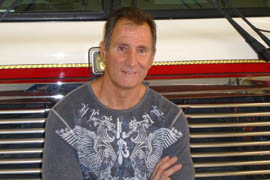Cronkite News has moved to a new home at cronkitenews.azpbs.org. Use this site to search archives from 2011 to May 2015. You can search the new site for current stories.
Arizona first responders helping study brain injury treatment
PHOENIX – Nearly three years after he survived a traffic accident that claimed the lives of four other motorcyclists, former Phoenix fire captain Ernie Lizarraga knows how lucky he is to be alive – let alone able to drive again.
Beyond the numerous broken bones, collapsed lung and lacerated liver and kidney, Lizarraga was left with significant brain damage. But thanks to modern medicine and not a small amount of hard work and support, he continues to defy expectations.
“I’ve amazed many doctors with what I’m doing now,” Lizarraga said. “Just walking, you know? And riding a motorcycle.”
Now, funded by $3.7 million in grants from the National Institutes of Health, thousands of first responders are contributing to a project to ensure that victims of traumatic brain injuries have the chance to recover as well as Lizarraga has.
The Excellence in Prehospital Injury Care (EPIC) project is a collaboration among Arizona fire departments and districts, providers of ground and air medical transport, the University of Arizona College of Medicine-Phoenix and the Arizona Department of Health Services. The goal: implementing and evaluating the national standards for treating traumatic brain injuries before patients reach the hospital.
Dr. Ben Bobrow, co-director of EPIC and medical director for the Arizona Department of Health Services Bureau of EMS and Trauma System, said the initiative uses standards for treating traumatic brain injuries developed by the Brain Trauma Foundation.
There currently is no requirement that the standards be followed, creating a disconnect between expected and actual medical care, Bobrow said.
“Nobody mandates it, but the public expects it,” he said. “John Doe, he expects if he has a head injury that somebody’s going to respond and know exactly what to do, and be able to do it really well.”
Much of what those standards deal with are ways to help victims breathe. Previous medical consensus held that rapidly ventilating patients and keeping their blood pressure low were essential to successful treatment, but Bobrow said that was found to be false over the last decade.
“Those two things, along with hypoxia, are basically deadly for an injured brain,” he said. “Our old guidelines used to help us kill people. And we got really good at doing those things.”
Agencies that participate in EPIC receive breathing devices to assist in ventilating patients correctly as part of a donation from the Ramsey Justice Foundation.
The grant was awarded in March 2011, and data collection is scheduled to continue through 2015.
Nearly 200 fire departments, districts and other agencies statewide are participating in the project in some manner.
Mike Allen, a paramedic who helps to run the EMS program for the Summit Fire District near Flagstaff, said that the reception to EPIC has been a warm one.
“The ultimate goal is increasing the patient outcome with traumatic brain injuries, so anything we can do to better that outcome and increase the chance of survivability and better way of life for those patients that receive traumatic brain injuries,” he said. “Everybody is on board with that.”
Mark Venuti, the director of Guardian Medical Transport in Flagstaff, said that although it was too early to tell if EPIC is making an empirical difference, the initial anecdotal returns have been encouraging.
“I think what I’m hearing back so far is that everybody is really doing a good job on applying the new training and there has been positive feedback about how that’s going,” he said. “Intuitively, I think there has been a positive impact, but I don’t have the math that would support it.”
Bobrow said that EPIC is just now starting to collect a wide variety of data to assess the impact on patient outcomes. This data includes survival, neurologic status and length of stay in the hospital.
He said he hopes EPIC not only leads to 100 percent cooperation from Arizona first responders but also a change in hospital procedures.
“We want to have the same, seamless evidence-based care throughout the entire spectrum of care,” Bobrow said. “So ultimately, we would like to – and we believe EPIC will – actually transcend into the hospitals, and we will be doing EPIC care inside the hospitals.”
That way, more people will be able to defy the odds and give back to those who supported them through their injury, much like Ernie Lizarraga. He’s now grateful to have the chance to do so through his continued involvement with the Phoenix Fire Department’s driver training program as a safety officer.
“They helped me a whole lot. It’s my turn to help them as much as I can,” he said.







